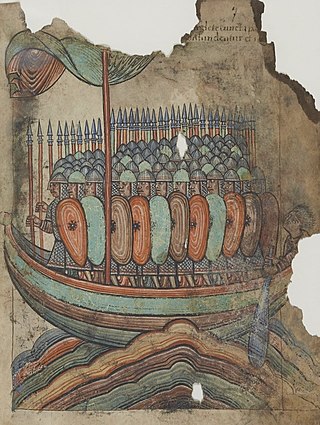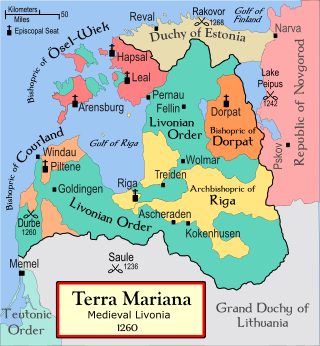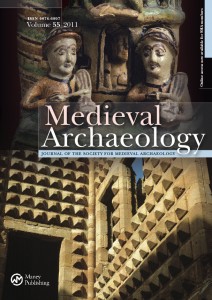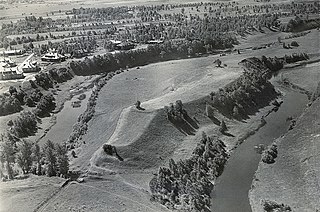
The Northern Crusades or Baltic Crusades were Christianization campaigns undertaken by Catholic Christian military orders and kingdoms, primarily against the pagan Baltic, Finnic and West Slavic peoples around the southern and eastern shores of the Baltic Sea.

Scandinavia is a subregion of Northern Europe, with strong historical, cultural, and linguistic ties between its constituent peoples. Scandinavia most commonly refers to Denmark, Norway, and Sweden. It can sometimes also refer to the Scandinavian Peninsula. In English usage, Scandinavia is sometimes used as a synonym for Nordic countries. Iceland and the Faroe Islands are sometimes included in Scandinavia for their ethnolinguistic relations with Sweden, Norway and Denmark. While Finland differs from other Nordic countries in this respect, some authors call it Scandinavian due to its economic and cultural similarities.

The Viking Age was the period during the Middle Ages when Norsemen known as Vikings undertook large-scale raiding, colonising, conquest, and trading throughout Europe and reached North America. The Viking Age applies not only to their homeland of Scandinavia but also to any place significantly settled by Scandinavians during the period. The Scandinavians of the Viking Age are often referred to as Vikings as well as Norsemen, although few of them were Vikings in the sense of being engaged in piracy.

Vikings were seafaring people originally from Scandinavia, who from the late 8th to the late 11th centuries raided, pirated, traded, and settled throughout parts of Europe. They also voyaged as far as the Mediterranean, North Africa, the Middle East, Greenland, and Vinland. In their countries of origin, and some of the countries they raided and settled in, this period is popularly known as the Viking Age, and the term "Viking" also commonly includes the inhabitants of the Scandinavian homelands as a whole. The Vikings had a profound impact on the early medieval history of Scandinavia, the British Isles, France, Estonia, and Eastern Europe.

In folklore, a werewolf, or occasionally lycanthrope, is an individual who can shape-shift into a wolf, or especially in modern film, a therianthropic hybrid wolf-like creature, either purposely or after being placed under a curse or affliction, often a bite or the occasional scratch from another werewolf, with the transformations occurring on the night of a full moon. Early sources for belief in this ability or affliction, called lycanthropy, are Petronius (27–66) and Gervase of Tilbury (1150–1228).
Year 1252 (MCCLII) was a leap year starting on Monday of the Julian calendar.
Viking metal is a subgenre of heavy metal music characterized by a lyrical and thematic focus on Norse mythology, Norse paganism, and the Viking Age. Viking metal is quite diverse as a musical style, to the point where some consider it more a cross-genre term than a genre, but it is typically heard as black metal with influences from Nordic folk music. Common traits include a slow-paced and heavy riffing style, anthemic choruses, use of both sung and harsh vocals, a reliance on folk instrumentation, and often the use of keyboards for atmospheric effect.

The Creswellian is a British Upper Palaeolithic culture named after the type site of Creswell Crags in Derbyshire by Dorothy Garrod in 1926. It is also known as the British Late Magdalenian. According to Andreas Maier: "In current research, the Creswellian and Hamburgian are considered to be independent but closely related entities which are rooted in the Magdalenian." The Creswellian is dated between 13,000 and 11,800 BP and was followed by the most recent ice age, the Younger Dryas, when Britain was at times unoccupied by humans.

Anglo-Saxon paganism, sometimes termed Anglo-Saxon heathenism, Anglo-Saxon pre-Christian religion, Anglo-Saxon traditional religion, or Anglo-Saxon polytheism refers to the religious beliefs and practices followed by the Anglo-Saxons between the 5th and 8th centuries AD, during the initial period of Early Medieval England. A variant of Germanic paganism found across much of north-western Europe, it encompassed a heterogeneous variety of beliefs and cultic practices, with much regional variation.
Martin Giles Palmer is a theologian, Sinologist, author and international specialist on all major faiths and religious traditions and cultures. He is the Founding President and Chief Executive of FaithInvest, an international not-for-profit membership association for religious groups and faith-based institutional investors, which empowers faith groups to invest in line with their values. FaithInvest grew out of the Alliance of Religions and Conservation (ARC) of which Palmer was Secretary General from 1995 to 2019. Palmer is also the Director of the International Consultancy on Religion, Education and Culture (ICOREC).

Ancient Estonia refers to a period covering History of Estonia from the middle of the 8th millennium BC until the conquest and subjugation of the local Finnic tribes in the first quarter of the 13th century during the Teutonic and Danish Northern Crusades.
Roberta Lynn Gilchrist, FSA, FBA is a Canadian-born archaeologist and academic specialising in the medieval period, whose career has been spent in the United Kingdom. She is Professor of Archaeology and Dean of Research at the University of Reading.

The Baltic Finnic peoples, often simply referred to as the Finnic peoples, are the peoples inhabiting the Baltic Sea region in Northern and Eastern Europe who speak Finnic languages. They include the Finns, Estonians, Karelians, Veps, Izhorians, Votes, and Livonians. In some cases the Kvens, Ingrians, Tornedalians and speakers of Meänkieli are considered separate from the Finns.

The Rus', also known as Russes, were a people in early medieval Eastern Europe. The scholarly consensus holds that they were originally Norsemen, mainly originating from present-day Sweden, who settled and ruled along the river-routes between the Baltic and the Black Seas from around the 8th to 11th centuries AD.

Terra Mariana was the formal name for Medieval Livonia or Old Livonia. It was formed in the aftermath of the Livonian Crusade, and its territories were composed of present-day Estonia and Latvia. It was established on 2 February 1207, as a principality of the Holy Roman Empire, and lost this status in 1215 when Pope Innocent III proclaimed it as directly subject to the Holy See.

Medieval Archaeology is an annual peer-reviewed academic journal covering the archaeology of the medieval period, especially in the United Kingdom and Ireland. It was established in 1957 by the Society for Medieval Archaeology and is published on their behalf by Taylor & Francis. The editor-in-chief is Aleks McClain.
Nora Berend is a Fellow of St Catharine's College, Cambridge and Professor of European History at the Faculty of History.
Naomi Sykes FSA is a zooarchaeologist and is currently the Lawrence Professor of Archaeology at the University of Exeter. Sykes researches human-animal relations in the past.

The Viking Age in Estonia was a period in the history of Estonia, part of the Viking Age. It was not a unified country at the time, and the area of Ancient Estonia was divided among loosely allied regions. It was preceded by the Bronze and Early Iron Ages in Estonia, during which an agrarian society had developed, the Migration Period, and Pre-Viking Age with the Viking Age itself lasting between 800 and 1050 AD. It is often considered to be part of the Iron Age period which started around 400 AD and ended around 1200 AD. Some 16th-century Swedish chronicles attribute the Pillage of Sigtuna in 1187 to Estonian raiders.

Zantyr is a lost Teutonic Order castle with established commandry and town with cathedral, seat of the bishopric. In the early 13th century it was located at present day Pomeranian Voivodeship, in Sztum County, in the municipality of Sztum, south of the village Uśnice or in the region Biała Góra at the confluence of the rivers Nogat and Vistula. Here, at the southern end of the Vistula delta region, resides the Nogat River Protected Landscape Area. During its brief history Zantyr was contested between Swietopelk II, Duke of Pomerania, State of the Teutonic Order and Bishopric of Pomesania. At the end around year 1280 the castle and town were reestablished at a new location and became known as Malbork Castle.













